Prior to 1867,
Baden's
infantry had already worn a similar uniform to Prussia
(dark blue tunic with a spiked helmet or Pickelhaube).
From 1867 Baden adopted entirely Prussian
uniform, retaining only two differences.
-
The
Baden Pickelhaube Plate had the heraldic Griffon
above a scroll with the motto "MIT GOTT F. FUERST U.
VATERLAND" (With God for Prince, or Grand Duke, and
Fatherland). The Baden Griffon also replaced
the Prussian Eagle or Crown on NCO collar buttons and other insignia
where the Prussian army wore an eagle.
-
Baden
Colours (yellow/red/yellow) were used on insignia such as cockades
the left side of Pickelhaubes and on
field caps, trumpet cords, marksmanship lanyards,
one-year-volunteer shoulder straps, officers' belts and
on other uniform items when the Prussian army had black and white.
109th Baden Life-Grenadier
Regiment
The Badisches
Leib-Grenadier-Regt. Nr.109 was formed as the
Infanterie-Regiment Erbprinz on 23rd March 1803. The
regiment fought as allies of the French against Austria,
Prussia and Russia before siding with Prussia in the War of
Liberation of 1813. They also fought alongside Prussia
against Denmark in 1848-49. During the Austro-Prussian War
they fought the Prussians at the clashes alongside the
Tauber and in the Franco-Prussian War fought at the Battle
of Nuits.
Grand Duke Friedrich I of Baden
was colonel in chief of the regiment, succeeded by Grand Duke
Friedrich II in 1907.
In 1914 the regiment was garrisoned at Karlsruhe and like all Baden Infantry formed part of the XIV
Army Corps serving on the Western Front during the First World
War.
Recommended External Link
-
Karlsruhe StadtWiki
|
Uniform
Distinctions |
| Helmet Plate: |
White metal heraldic
Baden Griffon with the star of the Baden House Order of
the Loyal (Hausorden der Treue) on the breast.
Officers had the cross of the order enamelled in red. |
| Parade
Plume: |
White for I and II Btn,
black for III Btn |
| State
Cockade: |
Baden (yellow/red/yellow) |
| Capband and
piping: |
Red |
| Tunic
Buttons: |
White
metal |
| Shoulder
Straps: |
White with a red
crown |
| Collar: |
Red piped along the upper
edge in blue with white double Litzen |
| Cuffs: |
Swedish style in red
with white Litzen |
110th Grenadier Regiment "Emperor
Wilhelm I" (2nd Baden)
The 2. Badisches Grenadier-Regt. Kaiser
Wilhelm I. Nr.110 was formed on 22nd October 1852.
During the Austro-Prussian
War they fought the Prussians at the clashes alongside the
Tauber and in the Franco-Prussian War fought at the Battles of Nuits
and Lisaine and the Siege of Strasbourg.
From 1857 Prince Wilhelm of
Prussia (later Kaiser or Emperor Wilhelm I of Germany) was
colonel in chief and the regiment retained his name after his
death in 1888.
In 1914 the regiment was garrisoned at Mannheim;
with their II Btn at Heidelburg . Like all Baden Infantry they
formed part of the XIV Army Corps and served on the Western
Front during the First World War.
|
Uniform
Distinctions |
| Helmet Plate: |
Yellow metal heraldic
Baden Griffon. |
| Parade
Plume: |
White for I and II Btn,
black for III Btn |
| State
Cockade: |
Baden (yellow/red/yellow) |
| Capband and
piping: |
Red |
| Tunic
Buttons: |
Yellow metal |
| Shoulder
Straps: |
White with a red RWI
crowned monogram for Emperor Wilhelm I |
| Collar: |
Red piped along the upper
edge in blue |
| Cuffs: |
Brandenburg style in red |
111th Infantry Regiment "Margrave
Ludwig Wilhelm" (3rd Baden)
The Infanterie-Regt. Margraf Ludwig
Wilhelm (3. Badisches) Nr.111 was formed on 22nd October
1852. During the
Austro-Prussian War they fought the Prussians at the clashes
alongside the Tauber and in the Franco-Prussian War fought at
the Battle of Lisaine and the Siege of Strasbourg.
In 1891 the
3rd Baden Regiment received the title "Margrave Ludwig Wilhelm",
the second son of Grand Duke Friedrich I who had died at the age
of 22 three years before. The cause of death was officially
pneumonia but it was also alleged that he had been killed in a
duel.
In 1914 the regiment was
garrisoned at Rastatt. Like all Baden Infantry they formed part
of the XIV Army Corps and served on the Western Front during the
First World War.
|
Uniform
Distinctions |
| Helmet Plate: |
Yellow metal heraldic
Baden Griffon. |
| Parade
Plume: |
None |
| State
Cockade: |
Baden (yellow/red/yellow) |
| Capband and
piping: |
Red |
| Tunic
Buttons: |
Yellow metal |
| Shoulder
Straps: |
Red with a yellow
numeral 111, from 1902 this was changed to a yellow LW
crowned monogram for Margrave Ludwig Wilhelm |
| Collar: |
Red piped along the upper
edge in blue |
| Cuffs: |
Brandenburg style in red |
112th Infantry Regiment "Prince
Wilhelm" (4th Baden)
The 4. Badisches Infanterie-Regt. Prinz
Wilhelm Nr.112 was formed on 22nd October 1852.
During the Austro-Prussian
War they were garrisoned at Rastatt and saw no action. In the
Franco-Prussian War fought at the Siege of Strasbourg.
The
regiment was named in 1871 after its colonel in chief, Prince
Wilhelm of Baden (third son of Grand Duke Leopold) and retained
his name after his death in 1897.
In 1914 the regiment was
garrisoned at Mülhausen in Alsace (modern Mulhouse, France).
Like all Baden Infantry they formed part of the XIV Army Corps
and served on the Western Front during the First World War.
|
Uniform
Distinctions |
| Helmet Plate: |
Yellow metal heraldic
Baden Griffon. |
| Parade
Plume: |
None |
| State
Cockade: |
Baden (yellow/red/yellow) |
| Capband and
piping: |
Red |
| Tunic
Buttons: |
Yellow metal |
| Shoulder
Straps: |
Yellow with a red
numeral 112 |
| Collar: |
Red piped along the upper
edge in blue |
| Cuffs: |
Brandenburg style in red |
113th Infantry Regiment (5th Baden)
The 5. Badisches Infanterie-Regt. Nr.113
was formed on 16th February 1861.
During the Austro-Prussian War they
fought the Prussians at the clashes alongside the Tauber and in
the Franco-Prussian War fought at the Battle of Lisaine and the
Siege of Strasbourg. In 1891 Crown Prince (Erbgroßherzog)
Friedrich (later Grand Duke Friedrich II) was appointed colonel
in chief.
In 1914 the regiment was
garrisoned at Freiburg. Like all Baden Infantry they formed part
of the XIV Army Corps and served on the Western Front during the
First World War.
|
Uniform
Distinctions |
| Helmet Plate: |
Yellow metal heraldic
Baden Griffon. |
| Parade
Plume: |
None |
| State
Cockade: |
Baden (yellow/red/yellow) |
| Capband and
piping: |
Red |
| Tunic
Buttons: |
Yellow metal |
| Shoulder
Straps: |
Blue with a red
numeral 113 |
| Collar: |
Red piped along the upper
edge in blue |
| Cuffs: |
Brandenburg style in red |
114th Infantry Regiment "Emperor
Friedrich III" (6th Baden)
The 6. Badisches
Infanterie-Regt. Kaiser Friedrich III Nr.114 was formed on
26th October 1867 and first saw action against France in 1870-71
at the Battle of Lisaine and the Siege of Metz. In 1888 the
regiment was posthumously named after the recently deceased
German Emperor, Kaiser Friedrich III.
In 1914 the regiment was
garrisoned at Konstanz with a guard detachment at Hohenzollern
Castle. Like all Baden Infantry they formed part of the XIV Army
Corps and served on the Western Front during the First World
War.
|
Uniform
Distinctions |
| Helmet Plate: |
Yellow metal heraldic
Baden Griffon. |
| Parade
Plume: |
None |
| State
Cockade: |
Baden (yellow/red/yellow) |
| Capband and
piping: |
Red |
| Tunic
Buttons: |
Yellow metal |
| Shoulder
Straps: |
Green with a red FR
III crowned monogram for Emperor Friedrich III |
| Collar: |
Red piped along the upper
edge in blue |
| Cuffs: |
Brandenburg style in red |
142nd Infantry Regiment (7th Baden)
The 7. Badisches
Infanterie-Regt. Nr.142 was formed on 1st February 1890. In
1914 the regiment was garrisoned at Mülhausen in Alsace (modern
Mulhouse in France) with the II Btn in Mühlheim. Like all Baden
Infantry they formed part of the XIV Army Corps and served on
the Western Front during the First World War.
|
Uniform
Distinctions |
| Helmet Plate: |
Yellow metal heraldic
Baden Griffon. |
| Parade
Plume: |
None |
| State
Cockade: |
Baden (yellow/red/yellow) |
| Capband and
piping: |
Red |
| Tunic
Buttons: |
Yellow metal |
| Shoulder
Straps: |
Yellow
with a red numeral 142 |
| Collar: |
Red piped along the upper
edge in blue |
| Cuffs: |
Brandenburg style in red |
169th Infantry Regiment (8th Baden)
The 8. Badisches
Infanterie-Regt. Nr.169 was formed on 31st Mach 1897. In
1914 the regiment was garrisoned at Lahr, with their II Btn at
Vilingenand. Like all Baden Infantry they formed part of the XIV
Army Corps and served on the Western Front during the First
World War.
|
Uniform
Distinctions |
| Helmet Plate: |
Yellow metal heraldic
Baden Griffon. |
| Parade
Plume: |
None |
| State
Cockade: |
Baden (yellow/red/yellow) |
| Capband and
piping: |
Red |
| Tunic
Buttons: |
Yellow metal |
| Shoulder
Straps: |
Red with a yellow
numeral 169 |
| Collar: |
Red piped along the upper
edge in blue |
| Cuffs: |
Brandenburg style in red |
170th Infantry Regiment (9th Baden)
The 9. Badisches Infanterie-Regt. Nr.170
was formed on 31st March 1897.
In 1914 the regiment was garrisoned
at Offenburg, with their III Btn.at Donaueschingenand. Like all
Baden Infantry they formed part of the XIV Army Corps and served
on the Western Front during the First World War.
|
Uniform
Distinctions |
| Helmet Plate: |
Yellow metal heraldic
Baden Griffon. |
| Parade
Plume: |
None |
| State
Cockade: |
Baden (yellow/red/yellow) |
| Capband and
piping: |
Red |
| Tunic
Buttons: |
Yellow metal |
| Shoulder
Straps: |
Blue with a red
numeral 170 |
| Collar: |
Red piped along the upper
edge in blue |
| Cuffs: |
Brandenburg style in red |
Sources
Websites and Online Sources
Kaiser's
Bunker
Pickelhaubes Forum
Colonel
J's Imperial German Musings
Genealogy.de Der Alten Armee
Books and
Published Sources
"Das Deutsche Heer,
Friedensuniformen bei Ausbruch des Weltkrieges " H Knötel and P
Pietsch (Diepenbroick-Grüter & Schulz 1935)
"Imperial German Headgear 1888-1914 Field Guide" JD Turinetti
and A O'Connor (Kaiser
Helmets 2006)
"Imperial German Army Handbook 1914-18" D Nash (Ian Allen 1980)
"Handbook of Imperial Germany" J & J Robinson (Authorhouse 2009)
"The Organisation of the German State Forces in 1866" S
Sutherland (Helion 2001)
"Das Deutsche Reichsheer" G Krickel and G Lange (1892)
"Die feldgraue Uniformierung des
deutschen Heeres 1907-1918"
J Kraus and
W Hanne (Verlag
Militaria 2009)
Museums and Collections
Military Museum, Rastatt
(formerly the Baden Army Museum)
Bavarian Army Museum, Ingolstadt
Army Museum, Brussels
Joe Robinson
Photo Collection
|
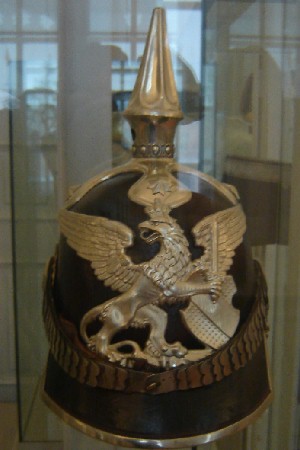
Pre-1867 Baden Infantry
Pickelhaube
Photo by C Dale
at the
Military Museum, Rastatt
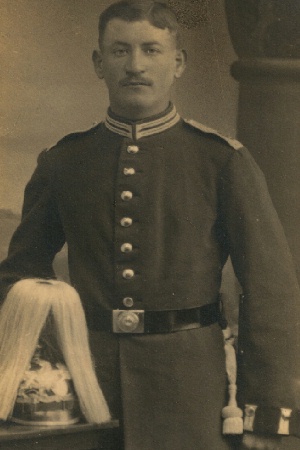
Grenadier of the
109th Life Grenadier Regiment
Photo ©
Joe Robinson
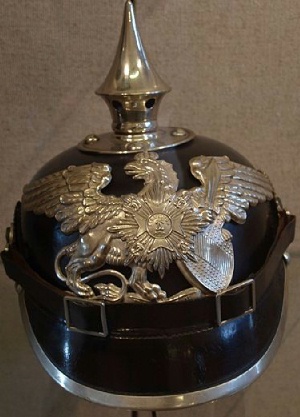
Other Ranks Pickelhaube from the
109th Life Grenadier Regiment
Note the white metal fittings and the
star on the breast of the heraldic griffon.
Photo by Manfred Hattenkerl at Festungsmuseum
Philippsburg /
Karlsruhe StadtWiki
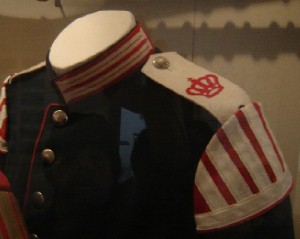
Musicians Uniform from the
109th Life Grenadier Regiment
Note the collar Litzen, crown on the shoulder strap and
musicians swallows nest on the shoulder
Photo by C Dale
at the
Military Museum, Rastatt
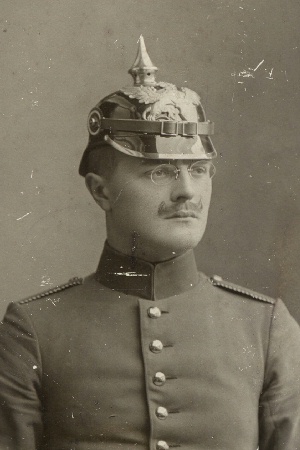
One Year Volunteer of the 111th Regiment
Photo ©
Joe Robinson
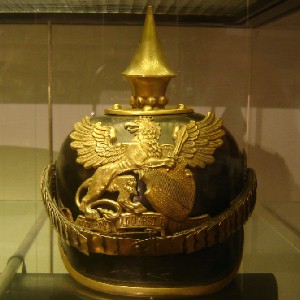
Pickelhaube from the Baden Line
Infantry
Photo by C Dale
at the
Military Museum, Rastatt
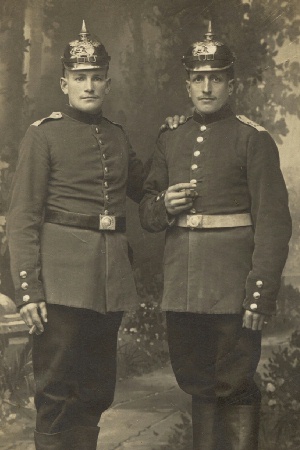
Two soldiers of the 142nd
Regiment
Photo ©
Joe Robinson
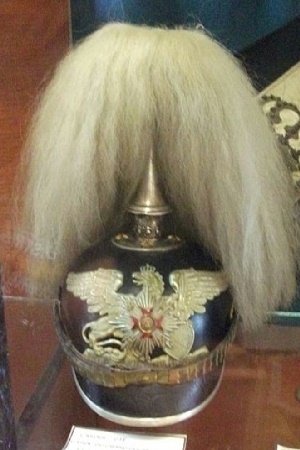
Officers Pickelhaube from the
109th Life Grenadier Regiment
Note the officers enamelled red cross in the centre of the
House Order star and the white horsehair parade plume of the I
and II Btns..
Photo by Gérald Garitan
at Fort de la Pompelle /
WikiCommons
|